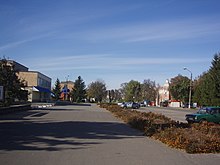Sinkiv
| Sinkiv | ||
| Зіньків | ||

|
|
|
| Basic data | ||
|---|---|---|
| Oblast : | Poltava Oblast | |
| Rajon : | Sinkiv Raion | |
| Height : | 122 m | |
| Area : | 11.37 km² | |
| Residents : | 10,116 (January 1, 2006) | |
| Population density : | 890 inhabitants per km² | |
| Postcodes : | 38100 | |
| Area code : | +380 5353 | |
| Geographic location : | 50 ° 12 ' N , 34 ° 21' E | |
| KOATUU : | 5321310100 | |
| Administrative structure : | 1 city , 5 villages | |
| Address: | вул. Леніна 67 38 100 м. Зіньків |
|
| Statistical information | ||
|
|
||
Sinkiw ( Ukrainian Зіньків ; Russian Зеньков Senkow , Polish Zieńków ) is a city in the central Ukrainian Poltava Oblast on the banks of the Tashan River . It is the administrative seat of the Rajons of the same name . The town also includes the villages of Syverynivka ( Сиверинівка ), Dubiwka ( Дубівка ), Pylypenky ( Пилипенки ), Hussaky ( Гусаки ) and Chmariwka ( Хмарівка ).
history
The place is first mentioned in 1604 when this area was part of the Polish-Lithuanian Empire . During this time a fort was built in Sinkiw. From 1648 the place was part of the Poltaw Regiment in the course of the Cossack struggle for independence, but came to the Russian Empire from the end of the 17th century . In 1781 Sinkiw was granted city rights and coats of arms. In 1783 there were 7,212 inhabitants, including 3,596 men and 3,616 women. From 1796 Sinkiw belonged to the Little Russian Governorate, in 1802 it became part of the Poltava Governorate.
In the first half of the 19th century the population increased sharply. While 6,707 people lived in the city in 1805, in 1862 there were already 9,810, including 5,117 men and 4,693 women. Thereafter the population decreased to 9,377 inhabitants by 1891, of which 4,590 were men and 4,787 women, whereby the proportion of Jews was 9.4%. By 1897, however, the population rose again to 10,443. Among them, the Ukrainians made up the largest ethnic group with 85.8%. Other larger groups were Jews (12.1%) and Russians (1.8%). In 1912 a boys 'and in 1915 a girls' grammar school was opened, and in 1920 an industrial and technical school.
During the 20th century, the city's growth stagnated, partly due to human losses from the Russian Civil War , famine, and World War II . In addition, it also played a role that the city only has one narrow-gauge railway connection. In 1970 the place had a dairy, a vegetable canning factory and two furniture factories.
After 12,300 inhabitants lived in the city in 1970, the number fell to 10,210 by 1979. In the 1980s, the number increased slightly to 11,244 inhabitants by 1989. The number was thus only slightly above that of 1897. Since then, the population has declined slightly in the wake of the transition crisis.
Economy and Transport
The city's economic focus is on the food industry . Sinkiv is located on the T-1706 territorial road that connects Hajach with Poltava . The city is only connected to the railway network via a narrow-gauge railway, which connects it to Ochtyrka .
sons and daughters of the town
- Praskowja Parchomenko (1887–1970), Ukrainian-Soviet astronomer
- Mykola Serow (1890–1937), Ukrainian classical philologist, translator and poet
Web links
- Map of the vicinity of the city
- Information page of the Association of Ukrainian Cities (Ukrainian)
- Information about the narrow-gauge railway (Russian) ( Memento from December 21, 2003 in the Internet Archive )
Individual evidence
- ↑ Tschyselnist najawnoho naselennja Ukrajiny, Kiev 2006



